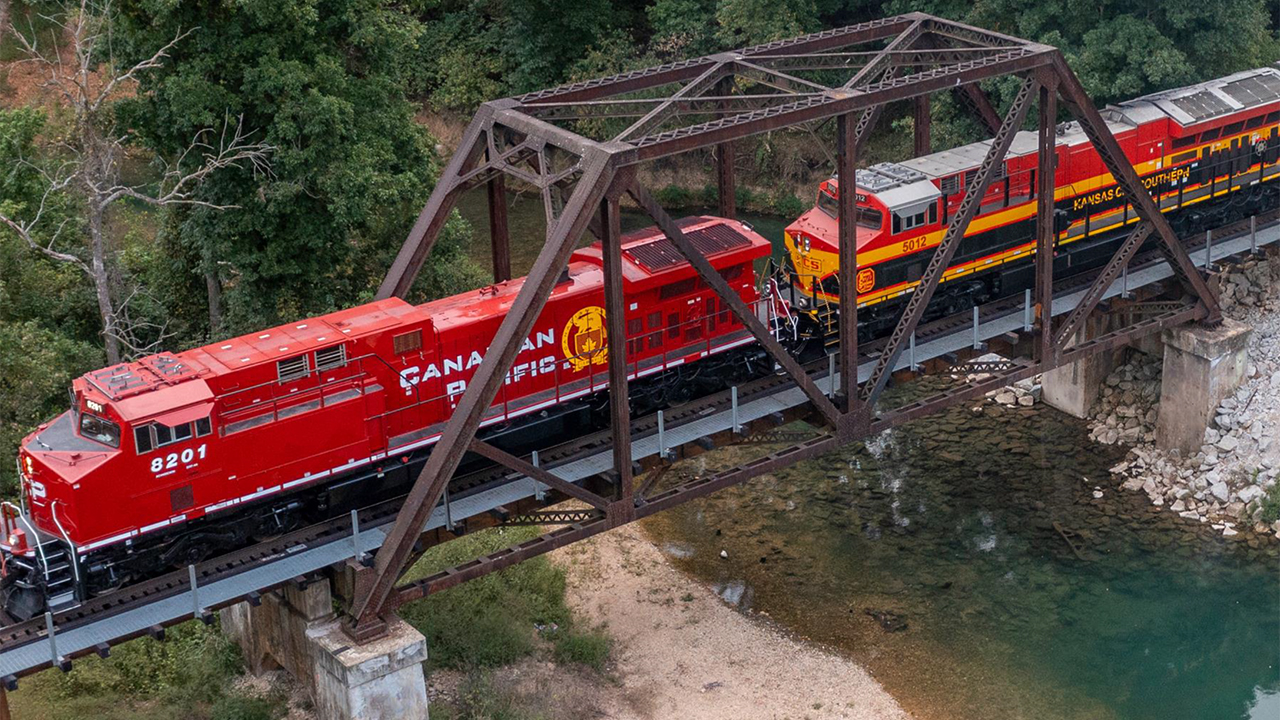
TD Cowen 1Q24 Rail Shipper Survey Says …
Written by Jason Seidl, Matt Elkott, Elliot Alper and Uday Khanapurkar, TD Cowen
CPKC image.
Our survey is comprehensive and covers a broad range of industrial and consumer industries, among others. Chemicals, Transportation, and Manufacturing comprised the largest percentages of participants. Shippers completing this survey had approximately $29 billion of transportation spend.
A 3.1% rate increase is expected over the next 6-12 months, down sequentially and below the survey average. Business growth expectations and economic confidence modestly improved. Shippers continue to favor UNP and CPKC cross border intermodal service. 40% of shippers that have applicable freight are considering shifting coasts. We view the survey results as a neutral/negative for the U.S. rail group.
Pricing Expectations Decreased Modestly, Sequentially
Shippers anticipate rail prices will increase by 3.1% over the next 6-12 months, 30bps below last quarter’s survey. The 3.1% came in below the survey’s long-term average of 3.5%. Results of decelerating expectations align with industry commentary we’ve heard, particularly on the intermodal bid season, which JBHT highlighted as being increasingly competitive this year. TL rates that have not seen an inflection should continue to suppress rail pricing. Panelists on our recent Suds with Seidl called out strength in certain commodity groups (chemicals, paper, bulk) and weakness in others, largely in the energy group.
Shippers Continue to Favor CPKC and Falcon Services for Cross-Border Moves
40% of shippers in our survey engage in cross-border intermodal services (up 2% from the prior quarter). Of those, 42% stated they do not use an intermodal service for their moves. Of those that do, UNP and CPKC led the group as the most popular intermodal service, with 16% of shippers using their services. On time percentage came in at 55.8% in Q1, up from 48% last quarter (we note a wide range of answers). On avg, shippers plan to move 26% of their cross-border volumes to intermodal services in the coming year, up 9% sequentially. This underscores the growing Mexico-U.S. trade routes being driven by continued near-shoring trends.
Business Growth Expectations Stepped Up Sequentially, Below Survey Average
Business growth expectations over the next 12 months increased 30bps to 2.1% in Q1, though still below the survey’s long-term average of 3.6%. We are encouraged to see two quarters of (modest) business outlook improvement, and this may be attributed to U.S. carrier volume growth of 2.5% in Q1 which is better than anticipated, as most management teams were uncertain of carloading outlook during their Q4 calls. Economic confidence stepped up 4% points sequentially. Rail shippers are having less trouble hiring employees (down 3% pts sequentially), which is what we heard on our Suds call, where short lines noted that employee turnover rates stabilized in 2023 following increasingly difficult hiring and retention conditions in 2022.
Shippers Consider Shifting Freight to the West Coast
18% of shippers stated they moved volumes to the West Coast in the past 6 months (50% had not and 33% stated it was not applicable). Of the 40% of shippers that have applicable freight and are considering shifting coasts, 25% of them are considering 0%-5% of their volumes, 50% are considering 5%-10% of volumes, and 25% of shippers may move more than 10%.
Thoughts Into Rail Earnings
Decelerating pricing expectations, offset with marginally improving business outlook and economic confidence leads us to a ~neutral to slight negative read-through for the U.S. rail group. The rails benefit from lapping easy comparisons while rail inflationary pressures continue to ease. Rail pricing stepping down compared to Q4 should continue so long as TL spot rates continue to putter at trough levels.
Shippers anticipate rail prices to increase by 3.1% over the next 6-12 months, down 30bps compared to last quarter and below the survey average of 3.5%. Results suggest that persistently suppressed TL rates continue to offer stiff competition to rail modes through early bid season. JBHT called out increased competitiveness in intermodal bids at a conference earlier in Q1. Class I’s are likely to pass on elevated inflationary costs through renewals though the pricing-inflation gap is likely to remain under pressure in the near-term, suppressing margins.
25% of respondents indicated that truckload is a cheaper option than rail, a slight decline from last quarter’s 26% but still above the survey average response of ~20%. Results attest to our observation that shippers recognize cheap TL rates. Participants answering that rail is 0%-5% and 5%-10% cheaper is slightly above last quarter. On the other hand, those answering that rail is 10%-15% cheaper slipped 4% while more than 25% cheaper was flat compared to last quarter.
26% of intermodal shippers answered that truck is cheaper than rail compared to 23% a quarter ago. The proportion of shippers who answered that rail is 0%-5% cheaper was flat sequentially while 5%-10% cheaper was up 5%. Respondents answering that intermodal is 10-15% cheaper than truck dropped 3%. The left skew in results indicates that TL pricing at current suppressed levels compares favorably to intermodal rates.
28% of bulk shippers and 25% of intermodal shippers now report having shifted volumes onto the rails, up 5% and 4% respectively. Participants at our recent Railroad Happy Hour noted that improved rail service was starting to drive volumes on the network. OTR conversions should accelerate as TL rates recover though we do not expect this to materialize in 1H24.
“Concerns about tight TL capacity” ticked down slightly to 13% and remain depressed relative to 2022 levels. Participants that cited higher truck prices increased by 12% to 40%. 20% of shippers answered, “Improved Rail Service,” a 10% decrease over the prior quarter. “Environmental Concerns” increased by 7% and “Hours Of Service (HOS)/Other” was down 7%.
We asked shippers how much of a spot rate lift would prompt a shift to rail modes. On average, excluding outliers, shippers see a 36% increase in spot rates prompting a shift, up from ~20% in 4Q. Responses display a wide range from 2% to 150%. 32% of shippers answered that they are concerned about rail capacity, a 6% decrease compared to the prior quarter. The results are still significantly lower than post COVID levels amid modest volume growth on the U.S. Class I network. Compared to a quarter ago, 9% more shippers cited “Equipment,” 8% fewer cited “Track,” and 14% fewer answered “Manpower.”
46% of survey respondents report that the quality of rail service has impacted their modal choices flat compared to last quarter. Results are in line with our view that rail service quality has improved to reasonable levels.
We asked participants about their stance on shifting volumes to the West Coast. 18% of shippers answered that they had moved volumes to the West Coast in the past 6 months, 50% had not and 33% said it was not applicable to them. Of the 40% of shippers that have applicable freight and are considering shifting coasts, a quarter are considering 0%-5% of volume, half are considering 5%-10% and another quarter see more than 10%. The average “positive” (excellent or good rating) rating of Class I (including KCS, KCSM, and Ferromex) rail service ticked up materially in 1Q increasing 5% sequentially to 60%, an impressive result through a quarter that saw harsh winter weather. In 1Q, CSX and BNSF improved their service ratings materially. Positive service ratings remain above previous year’s levels for every rail. All U.S. Class I’s still have service ratings above their 5- year averages.
We asked shippers to rate the Class I’s by digital ease of use and freight visibility as technology becomes an increasingly central part of rails’ efficiency strategies. The average “positive” (excellent or good rating) rating of Class I’s digital ease of use rating was 59% in 1Q up 3% compared to last quarter.
In the bulk/carload category, 57% of survey respondents indicated they would push 0- 5% more freight toward the rails, down slightly vs last quarter. The percentages of shippers who indicated that they would push 5-10% to rails is up 4% sequentially and those responding 10-15% was up 1% sequentially. The percentage of shippers who indicated that they would push 15% or more freight to the railroads was down 4%.
On the intermodal side, 62% of shippers answered 0-5% more freight would be shifted to rails, roughly in line with last quarter. Participants responding that 5-10% of their freight would be shifted was also roughly flat. At 10-15% level, 5% more shippers would move, Finally, those answering they would move more than 15% of freight decreased 5% sequentially.
We again asked shippers how long service quality needs to persist at improved levels for OTR conversions to materialize. The percentage of shippers answering with 1 quarter increased significantly by 13 points to 27% indicating that shippers are become more confident in the resilience of the rail service proposition. Shippers answering 2 quarters increased 4% while those requiring a year of improved service declined 21%.
We again asked shippers about their cross-border intermodal choices. 40% of participants responded that they engage in cross-border shipping, up 2% from last quarter. Of those cross-border shippers, we asked participants which cross-border intermodal service they use. 42% responded that they do not use an intermodal service. In 1Q, UNP Falcon Premium and CPKC Mexico Midwest led the group with 16% of cross-border shippers responding that they use the respective services.
We again asked shippers for on-time percentage metrics for their cross-border shipments. Participants once again responded with a wide range of answers from 95% all the way down to 5%. On average, on-time percentage came in at 55.8%, above last quarter’s 48%.
We also asked shippers what proportion of their cross-border freight volume they anticipate shifting over to intermodal services in the coming year. On average, shippers plan to move 26% of volumes to intermodal up 9% sequentially with responses ranging from 5% to 58%.
We asked participants to opine on the increased service focus in the LTL industry and establish whether this benefits carriers more or shippers. 51% of participants in our survey reported using an LTL service. Survey results were unable to uncover a consensus on whether service orientation favors carriers with 25% responding it benefits shippers, 34% responding it benefits carriers and 42% responding that they could not determine the primary beneficiary.
Responses that ESG targets were a factor decreased to 23% compared to 25% last quarter. We continue to expect ESG factors to become increasingly incorporated over the long-term. Discussions with rail company management and shippers suggests that large shippers are already incorporating ESG elements into their transportation relationships and smaller shippers are expected to follow suit eventually.
Business growth expectations over the next 12 months ticked up 30bps to 2.1% though is still significantly below the survey’s 3.6% long-term average and below the 2016-present average of 2.4%. Survey results are in line with commentary on tepid volume outlook uncovered in our quarterly carrier survey.
The percentage of shippers expecting their employee counts to increase over the next 12 months was down 2 points at 37%. The percentage of shippers expecting to decrease headcount was up 2 points while those expecting it to be unchanged was roughly flat in the quarter.
We asked participants if their companies are having difficulty hiring employees. 46% of participants stated that they are having trouble hiring employees, down 3% from last quarter. 46% are not having trouble hiring employees, up 2% sequentially. Labor availability has eased considerably compared to 2022 levels. Economic confidence ticked up again with 40% of participants stating that they are more confident up 6% compared to the last quarter, contrasting with our carrier survey.
Business levels over the past few months were positive (“good,” “very good,” or “excellent”) for 53% of respondents, an increase from the prior quarter’s 51%. Poor performance has stepped up by a sizeable 11% in 1Q24.



